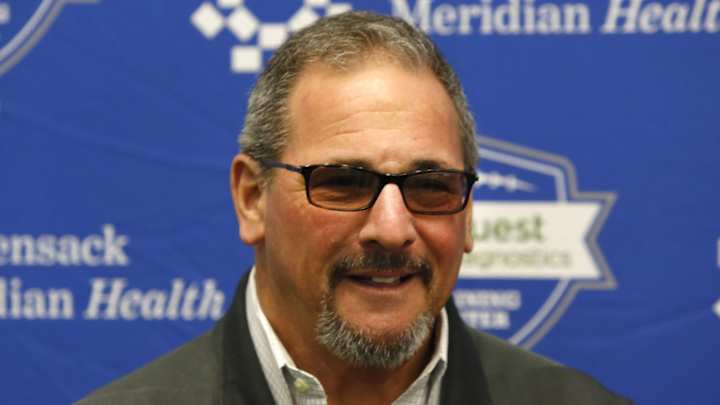Dave Gettleman on Leonard Williams: The Juice Was Worth the Squeeze

EAST RUTHERFORD, N.J. - Five months is a long time to go without talking, so when Giants general manager Dave Gettleman met with the media Tuesday morning, there was certainly a lot to catch up on.
One of the topics that dominated the half-hour session was the team’s decision to trade for defensive lineman Leonard Williams. Not long after the deal was made, Gettleman granted an interview to the team’s in-house marketing arm in which he touted the positives behind acquiring Williams for a third-round pick in 2020 and a fifth-round pick in 2021 that improves to a fourth-round pick if they Giants re-sign Williams. He is scheduled to be a free agent in March.
But the questions asked—and the answers provided—left the independent media who had hoped that Gettleman might choose to speak during the bye week to get everyone caught up on the thought processes and decisions made from the start of training camp until that point wanting closure.
Some of that closure came Tuesday morning, though some will probably argue that Gettleman’s explanations still don’t make enough sense.
Focusing on the Williams trade, let’s look at Gettleman’s responses.
On why he traded for Leonard Williams:
“The thought process was I really believe that as, as much as the style of play evolves, there are basic truths. You have to run the ball; you have to stop the run, you have to rush the passer. If you, if you're seriously deficient in any one of those three areas, it makes it tough. It's going to be tough sledding. We looked at it, you know, obviously abandonment the film by bringing him in, we felt he could be a disruptive force inside, and he has been.”
Pat’s Perspective: Gettleman isn’t wrong here, at least not according to the numbers. Before the Giants acquired Williams, the run defense was allowing 122.4 rushing yards per game; after Williams joined the team, that average fell to 104.1.
In running the numbers to see if that average was affected by teams running more or less against the Giants after the Williams trade, the difference is opponents ran the ball 2.4 fewer times against the Giants in the back half of the season.
It takes more than one player to move a mountain. Gettleman has spoken about how important it is to stop the run, and that’s an element Williams helped bring to the table, not just by the impact he made, but also the effect he had on his teammates such as Dalvin Tomlinson, who, per Pro Football Focus, recorded 14 of his 26 stops and 10 of his 14 tackles as credited by PFF once Williams arrived.
On why they didn’t wait until the end of the season and free agency to try to sign Williams:
“I understand what you’re saying, but at the end of the day, we felt good about him, he did what we wanted him to do, and he wants to be here.”
Pat’s Take: I was the one who asked Gettleman how he anticipated doing things moving forward in terms of changes he was going to make to his own approach, and part of his answer was exactly what I hoped he’d say:
“I’m going to learn from my mistakes. I never stop asking myself the question, ‘What could we have done differently? What could we have done better?’ That question never stops getting asked. I always ask that question. We evaluate, we re-evaluate, we go backward and forwards with it. And that’s what I’ve got to do. I’ve got to talk to other GMs, inside and outside the industry, and continue to grow.”
If there has been a mistake we can probably agree Gettleman has been guilty of making, it’s been overvaluing certain free agents.
Now some of the moves were necessary—Nate Solder had to get the contract he did because the Giants’ only other option was to stay with Ereck Flowers, which wasn’t going to work.
But Gettleman did not have to overspend on guys like Kareem Martin or Jonathan Stewart, and you wonder if he had been able to give each of those guys real-time auditions in the Giants system, would he have invested so heavily in them?
My guess is no, and I think that’s part of the reason why Gettleman saw this as a low-risk to bring Williams in here or an eight-game audition before backing up the Brinks truck to pay him a contract that was never going to match the return on the investment.
This is the “information” I believe Gettleman was trying to get on Williams.
Look, fans have been screaming (and rightfully so) about how the Giants overpaid for certain free agents that didn’t come close to yielding a positive return on the investment. And that, quite frankly, is how the Giants got into the salary cap mess they have spent the last two years trying to get out from under.
The bottom line is signing a big-ticket free agent rarely works out over the life of the contract. It doesn’t, which is why it’s so essential to build through the draft.
“Leonard is 25 years old, he’s young, he’s about to enter his prime,” Gettleman noted. “I felt that what he gave us with the potential that he gives us was worth those two assets.”
Only time will tell if he’s correct.
Some Final Thoughts on the Leonard Williams Trade
There are multiple angles behind why this move was made, but after piecing all of them together, my jury is still out (disclaimer: I haven’t done the film work yet to see just what kind of impact Williams made).
The first angle is that the Giants gave themselves exclusive negotiating rights with Williams up until the start of free agency. But that perspective is countered because it was apparent the Jets had no intention of retaining Williams after this year, so how much of an advantage did the Giants gain?
The other “advantage” Gettleman mentioned is that if they don’t re-sign Williams, they will likely get a high comp pick for him in 2021, as I noted in this article. But what good does that do the Giants in 2020 if the urgency for this team to start winning is right now?
Finally, this wasn’t discussed, but in speaking with a colleague, it was pointed out that Williams with five years experience under his belt, would probably grade out higher than any prospect the Giants might have drafted with that third-round pick.
I’m not sure I agree with that take either.
First, there was no way of knowing when the trade was made what the entire draft class will look like as the juniors haven’t yet all declared.
Second, who’s to say the Giants couldn’t have used that third-round pick on a position of greater need, such as a center or a linebacker and continued to develop B.J. Hill, whose playing time was reduced following the Williams acquisition?
It was also disturbing that there were times when Williams should have been on the field but was not due to a rotation—as stupid of an argument as there is as you put your best players on the field for every snap regardless of the rotation. But that’s on the coaching.
So I have to wonder if they truly have all the information they need to make an informed decision and if everyone in the organization at the time was really on the same page regarding the trade when it was made.
Make no mistake: The Giants do want to re-sign Williams. Gettleman revealed that the player was in his office Monday and said he wants to be here, but hey, we all want things until life presents a better option lures us in another direction.
We also know that there will probably be a new defensive coordinator who will run things very differently.
If Williams is converted to a 3-tech tackle in a pure 4-3, there is a significant difference in how a 3-4 defensive tackle and a 4-3 defensive tackle are paid (which is probably why the Giants didn’t open contract negotiations with Williams before the end of the 2019 season).
If the Giants believe that Williams is going to accept a contract that pays him as a complementary player, then maybe the trade won't look so bad in a few months.
